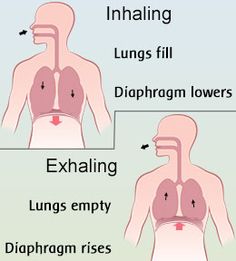4 Tricks To Feel Younger: Trick 4 – Breathing


Diaphragmatic Breathing
Diaphragm breathing is the use of our main breathing muscle, the diaphragm. The diaphragm is a dome shaped muscled that sits under the lungs. The image above shows the movement of the diaphragm as you breathe. Normally, when you breathe in, your diaphragm moves downwards into your abdomen. This downward movement creates a vacuum inside your chest that allows air to enter your lunges. Your diaphragm then moves in an upward direction when you breathe out, allowing air to leave your lunges.
Diaphragmatic Breathing and Core Muscles
Diaphragmatic breathing has an impact on your deep abdominal and pelvic floor muscles. Your trunk can be described as a cylinder surrounded by muscles that should work in conjunction with each other during breathing. The muscles surrounding your trunk cylinder include your deep abdominals muscles, diaphragm (top of cylinder), and your pelvic floor muscles (base of cylinder).
To help maintain pressure in your trunk cylinder during regular diaphragmatic breathing, your deep abdominals and pelvic floor muscles are activated. When you breathe in deeply during diaphragmatic breathing, the pressure inside your abdomen increases, so therefore your pelvic floor muscles have to contract to a greater extent to maintain this increased pressure. This is why learning diaphragmatic breathing and practicing deep breathing is very important, as it can help you promote the coordinated activity of your deep abdominal and pelvic floor muscles.
Posture, Breathing and Deep Abdominal Problems
It is difficult to fill your lungs and breathe deeply when you sit in a slumped forwards position. This is because this ‘C’ shaped spine position compresses your abdominal muscles and your diaphragm cannot move downwards. This causes your upper chest and neck muscles to over work and compensates to help you breathe.
In this slumped ‘C’ shape position, your deep abdominal and pelvic floor muscles do not receive the gentle ‘exercise’ they need to keep them activated; lengthening and contracting with every breathe in and out. This is why correct posture is so important for the activation and function of your diaphragm, pelvic floor and abdominals.
How to practice at home
Sign up and get £10 OFF your first booking